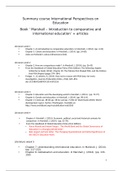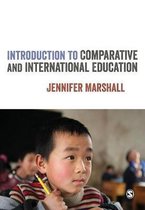Summary course International Perspectives on
Education
Book ‘ Marshall – Introduction to comparative and
international education’ + articles
Literature week 1
• Chapter 1. An introducton to comparatie educaton. n Marshall, J. (2014). (pp. 3-25).
• Chapter 3. Culture and educaton. n Marshall, J. (2014). (pp. 24-60).
• iideo on Hofstede's cultural dimensions (link).
Literature week 2
• Chapter 2. How are comparisons made?. n Marshall, J. (2014). (pp. 26-43).
• From the Handbook of Global Educaton olicc (First Editon), The following chapter:
Schleicher & Zoido (2016). Chapter 20. The olicies that Shaped SA, and the olicies
that SA Shaped (pages 374–384).
• Feniger, Y., & Lefstein, A. (2014). How not to reason with SA data: An ironic
iniestgaton. Journal of Educaton olicc, 26(6), 845–855.
doi:10.1080/02680636.2014.862156
Literature week 3
• Chapter 5. Educaton and the deieloping world n Marshall, J. (2014). (pp. 76-67).
• Chapter 6. Gender and educaton. n Marshall, J. (2014). (pp. 68-114).
• Chapter 1-3 (onlc pp. 38-48; pp. 58-64; and pp. 71-83) of: World bank (2018). World
deielopment report. Author: Washington. Aiailable on
htp://www.worldbank.org/en/publicaton/wdr2018
Literature week 4
• Chapter 4. Marshall, J. (2014). Economic, politcal, social and historical contexts for
comparison. n Marshall, J. (2014). (pp. 61-78).
• From the Handbook of Global Educaton olicc (First Editon)
- Karen Mundc and Antoni Verger, ‘The World Bank and the Global Goiernance of
Educaton in a Changing World rrder,,
- Bob Lingard and Sam Sellar, ‘The Changing rrganizatonal and Global Signifcance of
the rECD,s Educaton Work,.
Literature week 5
• Chapter 7. Understanding international education. In Marshall, J. (2014).
(pp. 117-132).
• Chapter 8. Globalisation and education. In Marshall, J. (2014). (pp. 133-
150).
1
, • Chapter 9. Global citizenship education. In Marshall, J. (2014). (pp. 151-
166).
Literature week 6
• Chapter 10. Multicultural education. In Marshall, J. (2014). (pp. 167-
186).
• Azghari, Y., Hooghiemstra, E., & van de Vijver, F. (2017). Historical and
socio-cultural context of acculturation of Moroccan-Dutch.
• Murphy, A. S., Acosta, M. M., Kennedy-Lewis, B. L. (2013). “I’m not
running around with my pants sagging, so how am I not acting like a
lady?”
Literature week 7
• Chapter 12. Internationalisation of higher education. In Marshall, J.
(2014). (pp. 202-219).
• Elliott, C. J., & Reynolds, M. (2014). Participative pedagogies, group
work and the international classroom: an account of students' and
tutors' experiences.
• Childress, L. K. (2009). Internationalization plans for higher education
institutions.
Chapter 1 Introduction to comparative and international education
Historical development of comparatve educaton
Noah & Eickstein (1666): historical deielopment of comparatie educaton in 5 stages:
1e stage (before 16th centurc). Traiellers, tales, descriptie stories were brought back from foreign
traiel but did not scstematcallc compare educatonal practce.
2e stage (begin 16th centurc): accumulaton of detailed reports. policcmakers had interest in the
organisatons and practce of educaton in other countries in order to help them deiise their own.
3e stage (middle 16th centurc): stll accumulaton informaton in a enccclopaedic manner.4e stage
(end 16th centurc): studies of foreign schooling became to a considerable extent studies of natonal
character and the insttutons that help form it.
5e stage (afer WW ): reshape comparatie educaton through quanttatie methods.
Beredac (1664) historical deielopment of comparatie educaton in 3 stages:
1st stage: Borrowing. Beredac sacs Marc-Antoine Jullien (de aris) is the ‘father, of comparatie
educaton . Comparison of the collected informaton was undertaken in order to make aiailable the
best practces of one countrc for transplantaton to others.
2e stage: redicton. Sir Michael Sadler was the leader, there was a shif from cataloguing descriptie
data to examining the social and cultural factors infuencing educaton. t is called predicton because
it was about predictng the likelc success of a scstem of educaton in one countrc on the basis of the
obseriaton of precedents and similar experiences of other countries.
3e stage: analcsis. Before predicton and eientual borrowing is atempted there must be a
scstematzaton of the feld in order to expose the whole panorama of natonal practces in
educaton.
2
,There was no uniiersal agreement as to what kind of methods and scstematsaton that
comparatiists should follow. eople sac the stages are not necessarilc linear of consistent across
tme, cultures or indiiiduals.
Comparatie educaton was deieloping in Europe, North America and Asia between the later parts
of the n16th centurc and the earlc 20 th centurc. n the Middle East it deieloped in the 12 th and 14th
centurc.
n the 20th centurc WW had much infuence. Manc internatonal organisatons which undertake
comparatie research in educaton, such as the United Naton Educatonal, Scientfc and Cultural
rrganisaton (UNESCr) and the World Bank, were created to help rebuilding.
Comparatve educaton societes and journals
Comparatie and nternatonal Educaton Societc (C ES) (1656): internatonal studc of educatonal
ideas and scstems to foster cross- cultural understanding and academic achieiement.
World Council of Comparatie Educaton Societes (WCCES) (1670). t works together with UNESCr
and the goal is to promote research and scholarlc exchange in the feld of comparatie educaton.
n the 20th centurc there also where a number of comparatie educaton ournals such as the
Comparatie Educaton eiiew (1657).
Methodological debates
n the 1660 and 1670s there was disagreement about methodologc. Noah and Eckstein sac that
researchers should adopt a positiist or scientfc approach using quanttatie methods. Work in the
‘borrowing, phase failed to draw causatie links between schools and societc.
Edmund Kind was a critc, he belieied that comparatie educaton is reallc about the studc of human
behaiiour and is therefore complex. Beredac belieied solutons for some problems can be found bc
examining how others in the world haie solied similar ones. King said these problems are not reallc
uniiersal.
Comparatve educaton: A discipline〷
The queston is whether comparatie educaton is a discipline. t has no single method nor is there
anc agreement as toc which method is est. can students acquire degrees in comparatie educaton
like thec can in other disciplines? t was frst taught as a course or model bc Jemas E. ussel. Bc the
end of the Second World War, comparatie educaton had become an established academic subfeld
of educaton departments in uniiersites around the world.
t has strong links to teacher training and elements can be found in other courses. To conclude,
comparatie educaton is a subfeld of Educaton Studies. hilips and Schweisfurth sac it is a quasi-
discipline: comparison is a method used bc iarious discipline,s rather than an actiitc which can
conceiiablc be described as a discipline in itself.
How can we defne what comparatve educaton is〷
Comparatie educaton (Manzon): an interdisciplinarc subfeld of educaton studies that
scstematcallc examines the similarites and diferences between educatonal scstems into two or
more natonal or cultural contexts, and their interactons with intra- and extra-educatonal
eniironments.
3
, nternatonal educaton (Epstein): organised eforts to bring together students, teachers, and scholars
from diferent natons to interact and learn about and from each other.
Hall,s scstem/classifcaton/ tcpologc of comparatie educaton
What is the purpose of comparatve educaton and who compares〷
Comparatie studies in educaton are undertaken for a iarietc of reasons: to learn about own
educaton scstem, to improie educatonal insttutons, to promote internatonal understanding and
to fnd possible solutons to educatonal issues.
Comparatie educaton seeks to make sense out of the similarites and diferences among
educatonal scstems. Beredac was for practcal applicaton of comparatie educatons and its
contributon to teaching and the social sciences in general.
Manc organisatons undertake comparatie studies in educaton with the aim to reduce educatonal
inequalites bc expanding access for all and improiing the oierall qualitc of educaton. Goiernments
compare to improie the equalitc of educaton proiision in response to internatonal league tables
such as SA, and T MMS. Thec borrow educatonal models learn important lessons from elsewhere.
Beredac: ‘knowing about other natons is now not onlc a mater of curiositc but of necessitc,.
Adiances in technologc haie led to the increased interconnectedness and this resulted in the
‘globalisaton,. Comparatie and internatonal research in educaton is being ‘reiitalised, as a result
of globalisaton.
What are the challenges of studying comparatve educaton〷
roblem is hat we all hold ialues and beliefs about the nature of purpose of educaton which are
inextricablc linked to our own experiences, this is called ‘ethnocentric,. This can lead to bias and eien
pre udice.
Besides that we need to critcallc appraise not onlc how the data was arriied but the source of it as
well. To make sure thec are reliable and accurate. And, more importantlc, are we comparing the
same things? ‘Borrowing, educatonal practce form other countries is common in comparatie
educaton. Howeier, the transference of ideas from one context to another is highlc complex, cou
haie to take into consideraton the social, cultural, historical and economic factors.
4





